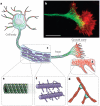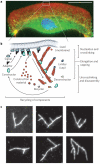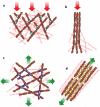Cell mechanics and the cytoskeleton
- PMID: 20110992
- PMCID: PMC2851742
- DOI: 10.1038/nature08908
Cell mechanics and the cytoskeleton
Abstract
The ability of a eukaryotic cell to resist deformation, to transport intracellular cargo and to change shape during movement depends on the cytoskeleton, an interconnected network of filamentous polymers and regulatory proteins. Recent work has demonstrated that both internal and external physical forces can act through the cytoskeleton to affect local mechanical properties and cellular behaviour. Attention is now focused on how cytoskeletal networks generate, transmit and respond to mechanical signals over both short and long timescales. An important insight emerging from this work is that long-lived cytoskeletal structures may act as epigenetic determinants of cell shape, function and fate.
Figures





Similar articles
-
Invited review: engineering approaches to cytoskeletal mechanics.J Appl Physiol (1985). 2000 Nov;89(5):2085-90. doi: 10.1152/jappl.2000.89.5.2085. J Appl Physiol (1985). 2000. PMID: 11053366 Review.
-
A computational tensegrity model predicts dynamic rheological behaviors in living cells.Ann Biomed Eng. 2004 Apr;32(4):520-30. doi: 10.1023/b:abme.0000019171.26711.37. Ann Biomed Eng. 2004. PMID: 15117025
-
Stress transmission within the cell.Compr Physiol. 2011 Jan;1(1):499-524. doi: 10.1002/cphy.c100019. Compr Physiol. 2011. PMID: 23737186 Free PMC article. Review.
-
Tug of war--the influence of opposing physical forces on epithelial cell morphology.Dev Biol. 2015 May 1;401(1):92-102. doi: 10.1016/j.ydbio.2014.12.030. Epub 2015 Jan 7. Dev Biol. 2015. PMID: 25576028 Review.
-
A predictive model of cell traction forces based on cell geometry.Biophys J. 2010 Nov 3;99(9):L78-80. doi: 10.1016/j.bpj.2010.09.024. Biophys J. 2010. PMID: 21044567 Free PMC article.
Cited by
-
Fibronectin-integrin signaling is required for L-glutamine's protection against gut injury.PLoS One. 2012;7(11):e50185. doi: 10.1371/journal.pone.0050185. Epub 2012 Nov 20. PLoS One. 2012. PMID: 23185570 Free PMC article.
-
Drops and fibers - how biomolecular condensates and cytoskeletal filaments influence each other.Emerg Top Life Sci. 2020 Dec 11;4(3):247-261. doi: 10.1042/ETLS20190174. Emerg Top Life Sci. 2020. PMID: 33048111 Free PMC article. Review.
-
Exact Length Distribution of Filamentous Structures Assembled from a Finite Pool of Subunits.J Phys Chem B. 2016 Jul 7;120(26):6225-30. doi: 10.1021/acs.jpcb.6b02242. Epub 2016 May 16. J Phys Chem B. 2016. PMID: 27135597 Free PMC article.
-
A "multi-omics" analysis of blood-brain barrier and synaptic dysfunction in APOE4 mice.J Exp Med. 2022 Nov 7;219(11):e20221137. doi: 10.1084/jem.20221137. Epub 2022 Aug 30. J Exp Med. 2022. PMID: 36040482 Free PMC article.
-
Multiparametric biophysical profiling of red blood cells in malaria infection.Commun Biol. 2021 Jun 8;4(1):697. doi: 10.1038/s42003-021-02181-3. Commun Biol. 2021. PMID: 34103669 Free PMC article.
References
-
- Weiss PA. In: The Molecular Control of Cellular Activity. Allen JM, editor. McGraw-Hill; 1961. pp. 1–72.
-
- dos Remedios CG, et al. Actin binding proteins: regulation of cytoskeletal microfilaments. Physiol. Rev. 2003;83:433–473. - PubMed
-
- Bieling P, et al. Reconstitution of a microtubule plus-end tracking system in vitro. Nature. 2007;450:1100–1105. - PubMed
Publication types
MeSH terms
Grants and funding
LinkOut - more resources
Full Text Sources
Other Literature Sources

